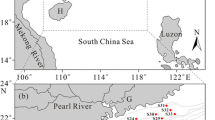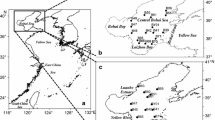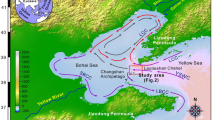Abstract
In an effort to assess the potential contamination and determine the environmental risks associated with heavy metals, the surface sediments in Liaodong Bay, northeast China, were systematically sampled and analyzed for the concentrations of Cu, Pb, Zn, Cr, Ni, As, and Hg. The metal enrichment factor (EF) and geoaccumulation index (I geo) were calculated to assess the anthropogenic contamination in the region. Results showed that heavy metal concentrations in the sediments generally met the criteria of China Marine Sediment Quality (GB18668-2002); however, both EF and I geo values suggested the elevation of Pb concentration in the region. Based on the effect-range classification (TEL-PEL SQGs), Cu, Pb, Ni, and As were likely to pose environment risks, and the toxic units decreased in the order: Ni > Pb > Cr > Zn > As > Cu > Hg. The spatial distribution of ecotoxicological index (mean-ERM-quotient) suggested that most of the surface sediments were “low–medium” priority zone. Multivariate analysis indicated that the sources of Cr, Ni, Zn, Cu, and Hg resulted primarily from parent rocks, and Pb or As were mainly attributed to anthropogenic sources. The results of this study would provide a useful aid for sustainable marine management in the region.






Similar content being viewed by others
References
Adams, W. J., Kimerle, R. A., & Barnett, J. W. (1992). Sediment quality and aquatic life assessment. Environmental Science & Technology, 26(10), 1864–1875. doi:10.1021/es00034a001.
Bergaya, F., Theng, B., & Lagaly, G. (2006). Modified clays and clay minerals. Handbook of Clay Sciences Developments in Clay Science, 1, 1246.
Christophoridis, C., Dedepsidis, D., & Fytianos, K. (2009). Occurrence and distribution of selected heavy metals in the surface sediments of Thermaikos Gulf, N. Greece. Assessment using pollution indicators. Journal of Hazardous Materials, 168(2–3), 1082–1091. doi:10.1016/j.jhazmat.2009.02.154.
CSBTS. (2002). Marine sediment quality. Beijing: Standards Press of China.
Dill, H. G. (2010). The “chessboard” classification scheme of mineral deposits: mineralogy and geology from aluminum to zirconium. Earth-Science Reviews, 100(1–4), 1–420. doi:10.1016/j.earscirev.2009.10.011.
Feng, H., Jiang, H., Gao, W., Weinstein, M. P., Zhang, Q., Zhang, W., et al. (2011). Metal contamination in sediments of the western Bohai Bay and adjacent estuaries, China. Journal of Environmental Management, 92(4), 1185–1197. doi:10.1016/j.jenvman.2010.11.020.
Gao, S., Luo, T.-C., Zhang, B.-R., Zhang, H.-F., Han, Y.-W., Zhao, Z.-D., et al. (1998). Chemical composition of the continental crust as revealed by studies in East China. Geochimica et Cosmochimica Acta, 62(11), 1959–1975. doi:10.1016/s0016-7037(98)00121-5.
Gao, X., & Chen, C.-T. A. (2012). Heavy metal pollution status in surface sediments of the coastal Bohai Bay. Water Research, 46(6), 1901–1911. doi:10.1016/j.watres.2012.01.007.
Gao, X., & Li, P. (2012). Concentration and fractionation of trace metals in surface sediments of intertidal Bohai Bay, China. Marine Pollution Bulletin, 64(8), 1529–1536. doi:10.1016/j.marpolbul.2012.04.026.
Gotelli, N. J., & Ellison, A. M. (2004). A primer of ecological statistics, first editon. Sunderland: Sinauer Associates.
Hamer, K., & Karius, V. (2002). Brick production with dredged harbour sediments. An industrial-scale experiment. Waste Management, 22(5), 521–530. doi:10.1016/S0956-053X(01)00048-4.
Hu, N., Shi, X., Huang, P., & Liu, J. (2010). Distribution of metals in surface sediments of Liaodong Bay, Bohai Sea. China Environmental Science, 30(3), 380–388.
Hyun, S., Lee, C. H., Lee, T., & Choi, J. W. (2007). Anthropogenic contributions to heavy metal distributions in the surface sediments of Masan Bay, Korea. Marine Pollution Bulletin, 54(7), 1059–1068. doi:10.1016/j.marpolbul.2007.02.013.
Ip, C. C., Li, X. D., Zhang, G., Wai, O. W., & Li, Y. S. (2007). Trace metal distribution in sediments of the Pearl River Estuary and the surrounding coastal area, South China. [Research Support, Non-U.S. Gov’t]. Environmental Pollution, 147(2), 311–323. doi:10.1016/j.envpol.2006.06.028.
Karageorgis, A. P., Anagnostou, C. L., & Kaberi, H. (2005). Geochemistry and mineralogy of the NW Aegean Sea surface sediments: implications for river runoff and anthropogenic impact. Applied Geochemistry, 20(1), 69–88. doi:10.1016/j.apgeochem.2004.07.008.
Larrose, A., Coynel, A., Schäfer, J., Blanc, G., Massé, L., & Maneux, E. (2010). Assessing the current state of the Gironde Estuary by mapping priority contaminant distribution and risk potential in surface sediment. Applied Geochemistry, 25(12), 1912–1923. doi:10.1016/j.apgeochem.2010.10.007.
Li, X., Liu, L., Wang, Y., Luo, G., Chen, X., Yang, X., et al. (2012). Integrated assessment of heavy metal contamination in sediments from a coastal industrial basin, NE China. PloS One, 7(6), e39690. doi:10.1371/journal.pone.0039690.
Liu, B., Hu, K., Jiang, Z., Qu, F., & Su, X. (2011). A 50-year sedimentary record of heavy metals and their chemical speciations in the Shuangtaizi River estuary (China): implications for pollution and biodegradation. Frontiers of Environmental Science & Engineering in China, 5(3), 435–444. doi:10.1007/s11783-011-0352-0.
Liu, S., Shi, X., Liu, Y., Zhu, Z., Yang, G., Zhu, A., et al. (2011). Concentration distribution and assessment of heavy metals in sediments of mud area from inner continental shelf of the East China Sea. Environmental Earth Sciences, 64(2), 567–579. doi:10.1007/s12665-011-0941-z.
Long, E. R., Field, L. J., & MacDonald, D. D. (1998). Predicting toxicity in marine sediments with numerical sediment quality guidelines. Environmental Toxicology and Chemistry, 17(4), 714–727. doi:10.1002/etc.5620170428.
Long, E. R., Ingersoll, C. G., & MacDonald, D. D. (2006). Calculation and uses of mean sediment quality guideline quotients: a critical review. Environmental Science & Technology, 40(6), 1726–1736. doi:10.1021/es058012d.
Long, E. R., & MacDonald, D. D. (1998). Recommended uses of empirically derived, sediment quality guidelines for marine and estuarine ecosystems. Human and Ecological Risk Assessment: An International Journal, 4(5), 1019–1039. doi:10.1080/10807039891284956.
Long, E. R., MacDonald, D. D., Smith, S., & Calder, F. (1995). Incidence of adverse biological effects within ranges of chemical concentrations in marine and estuarine sediments. Environmental Management, 19(1), 81–97. doi:10.1007/bf02472006.
Luo, W., Lu, Y., Wang, T., Hu, W., Jiao, W., Naile, J. E., et al. (2010). Ecological risk assessment of arsenic and metals in sediments of coastal areas of northern Bohai and Yellow Seas, China. Ambio, 39(5–6), 367–375. doi:10.1007/s13280-010-0077-5.
Müller, G. (1979). Schwermetalle in den sedimenten des Rheins-Veranderungen seitt. Umschau, 79, 778–783.
Müller, G. (1981). Die Schwermetallbelastung der sedimente des Neckars und seiner Nebenflusse: eine Bestandsaufnahme. Chemiker Zeitung, 105, 157–164.
Macdonald, D. D., Carr, R. S., Calder, F. D., Long, E. R., & Ingersoll, C. G. (1996). Development and evaluation of sediment quality guidelines for Florida coastal waters. Ecotoxicology, 5(4), 253–278. doi:10.1007/bf00118995.
MacDonald, D. D., Ingersoll, C. G., & Berger, T. A. (2000). Development and evaluation of consensus-based sediment quality guidelines for freshwater ecosystems. Archives of Environmental Contamination and Toxicology, 39(1), 20–31. doi:10.1007/s002440010075.
Meng, W., Qin, Y., Zheng, B., & Zhang, L. (2008). Heavy metal pollution in Tianjin Bohai Bay, China. Journal of Environmental Sciences, 20(7), 814–819. doi:10.1016/s1001-0742(08)62131-2.
Pan, K., & Wang, W.-X. (2012). Trace metal contamination in estuarine and coastal environments in China. The Science of the Total Environment, 421–422, 3–16. doi:10.1016/j.scitotenv.2011.03.013.
Pekey, H. (2006). Heavy metal pollution assessment in sediments of the Izmit Bay, Turkey. Environmental Monitoring and Assessment, 123(1–3), 219–231. doi:10.1007/s10661-006-9192-y.
Rubio, B., Nombela, M. A., & Vilas, F. (2000). Geochemistry of major and trace elements in sediments of the Ria de Vigo (NW Spain): an assessment of metal pollution. Marine Pollution Bulletin, 40(11), 968–980. doi:10.1016/s0025-326x(00)00039-4.
Sundaray, S. K., Nayak, B. B., Lin, S., & Bhatta, D. (2011). Geochemical speciation and risk assessment of heavy metals in the river estuarine sediments—a case study: Mahanadi basin, India. Journal of Hazardous Materials, 186(2–3), 1837–1846. doi:10.1016/j.jhazmat.2010.12.081.
Taylor, S. R. (1972). Abundance of chemical elements in the continental crust: a new table. Geochimica et Cosmochimica Acta, 28(8), 1273–1285.
Taylor, S. R., & McLennan, S. M. (1995). The geochemical evolution of the continental crust. Reviews of Geophysics, 33(2), 241–265. doi:10.1029/95rg00262.
Tessier, A., Campbell, P. G. C., & Bisson, M. (1979). Sequential extraction procedure for the speciation of particulate traces metals. Analytical Chemistry, 51, 844–851.
Tessier, E., Garnier, C., Mullot, J.-U., Lenoble, V., Arnaud, M., Raynaud, M., et al. (2011). Study of the spatial and historical distribution of sediment inorganic contamination in the Toulon bay (France). Marine Pollution Bulletin, 62(10), 2075–2086. doi:10.1016/j.marpolbul.2011.07.022.
Thomson, J., Higgs, N. C., Jarvis, I., Hydes, D. J., Colley, S., & Wilson, T. R. S. (1986). The behaviour of manganese in Atlantic carbonate sediments. Geochimica et Cosmochimica Acta, 50(8), 1807–1818. doi:10.1016/0016-7037(86)90140-7.
Turekian, K. K., & Wedepohl, K. H. (1961). Distribution of the elements in some major units of the Earth’s crust. Geological Society of America Bulletin, 72(2), 175–192. doi:10.1130/0016-7606(1961) 72[175:doteis]2.0.co;2.
Varol, M. (2011). Assessment of heavy metal contamination in sediments of the Tigris River (Turkey) using pollution indices and multivariate statistical techniques. Journal of Hazardous Materials, 195, 355–364. doi:10.1016/j.jhazmat.2011.08.051.
Wang, J., Chen, S., & Xia, T. (2010). Environmental risk assessment of heavy metals in Bohai Sea, North China. Procedia Environmental Sciences, 2, 1632–1642. doi:10.1016/j.proenv.2010.10.174.
Wang, S., Jia, Y., Wang, S., Wang, X., Wang, H., Zhao, Z., et al. (2010). Fractionation of heavy metals in shallow marine sediments from Jinzhou Bay, China. Journal of Environmental Sciences, 22(1), 23–31. doi:10.1016/s1001-0742(09)60070-x.
Wu, Z., He, M., & Lin, C. (2012). Environmental impacts of heavy metals (Co, Cu, Pb, Zn) in surficial sediments of estuary in Daliao River and Yingkou Bay (northeast China): concentration level and chemical fraction. Environmental Earth Sciences, 66(8), 2417–2430. doi:10.1007/s12665-011-1466-1.
Xu, B., Yang, X., Gu, Z., Zhang, Y., Chen, Y., & Lv, Y. (2009). The trend and extent of heavy metal accumulation over last one hundred years in the Liaodong Bay, China. Chemosphere, 75(4), 442–446. doi:10.1016/j.chemosphere.2008.12.067.
Zhang, J., & Liu, C. L. (2002). Riverine composition and estuarine geochemistry of particulate metals in China—weathering features, anthropogenic impact and chemical fluxes. Estuarine, Coastal and Shelf Science, 54(6), 1051–1070. doi:10.1006/ecss.2001.0879.
Zhang, L., Ye, X., Feng, H., Jing, Y., Ouyang, T., Yu, X., et al. (2007). Heavy metal contamination in western Xiamen Bay sediments and its vicinity, China. Marine Pollution Bulletin, 54(7), 974–982. doi:10.1016/j.marpolbul.2007.02.010.
Zhang, W., Feng, H., Chang, J., Qu, J., Xie, H., & Yu, L. (2009). Heavy metal contamination in surface sediments of Yangtze River intertidal zone: an assessment from different indexes. Environmental Pollution, 157(5), 1533–1543. doi:10.1016/j.envpol.2009.01.007.
Zhang, X. L. (2001). Investigation of pollution of Hg, Cd, Hg, As in sea water and deposit of Bohai Sea area. Environmental Journal of Heilongjiang, 25(3), 87–90.
Zheng, N., Wang, Q., Liang, Z., & Zheng, D. (2008). Characterization of heavy metal concentrations in the sediments of three freshwater rivers in Huludao City, Northeast China. Environmental Pollution, 154(1), 135–142. doi:10.1016/j.envpol.2008.01.001.
Zheng, N., Wang, Q., Zhang, X., Zheng, D., Zhang, Z., & Zhang, S. (2007). Population health risk due to dietary intake of heavy metals in the industrial area of Huludao city, China. The Science of the Total Environment, 387(1–3), 96–104. doi:10.1016/j.scitotenv.2007.07.044.
Zhou, H. Y., Peng, X. T., & Pan, J. M. (2004). Distribution, source and enrichment of some chemical elements in sediments of the Pearl River Estuary, China. Continental Shelf Research, 24(16), 1857–1875. doi:10.1016/j.csr.2004.06.012.
Acknowledgments
We thank two reviewers for their constructive and helpful comments. The authors acknowledge the financial supports by Ministry of Land and Resources (grant no. 1212011088110), National Natural Science Foundation of China (grant nos. 40976036, 40906033, and 41206049), Open Foundation of the State Key Laboratory of Loess and Quaternary Geology (grant no. SKLLQG1107), and Open Foundation of the Key Laboratory of Marine Hydrocarbon Resources and Environmental Geology (grant no. MRE201231).
Author information
Authors and Affiliations
Corresponding author
Rights and permissions
About this article
Cite this article
Hu, B., Li, J., Zhao, J. et al. Heavy metal in surface sediments of the Liaodong Bay, Bohai Sea: distribution, contamination, and sources. Environ Monit Assess 185, 5071–5083 (2013). https://doi.org/10.1007/s10661-012-2926-0
Received:
Accepted:
Published:
Issue Date:
DOI: https://doi.org/10.1007/s10661-012-2926-0




